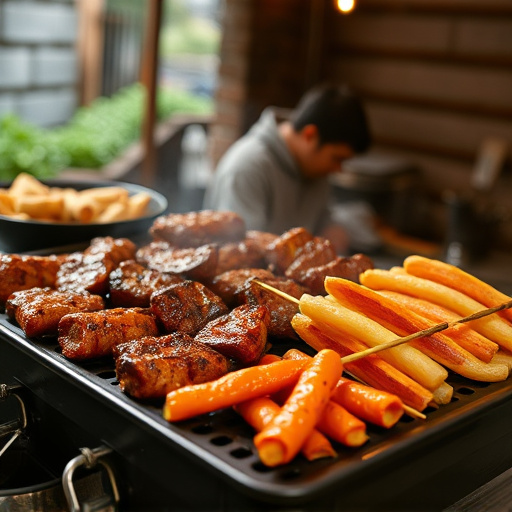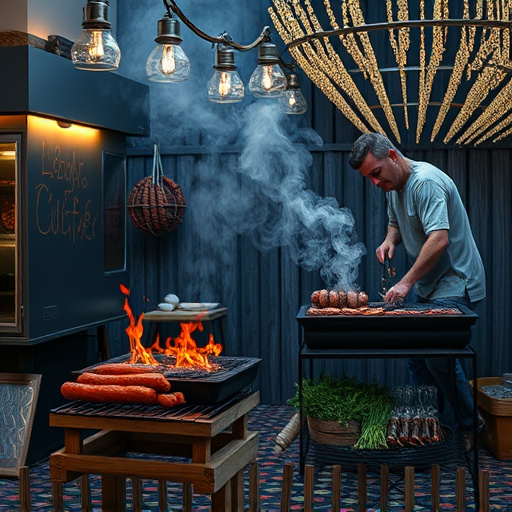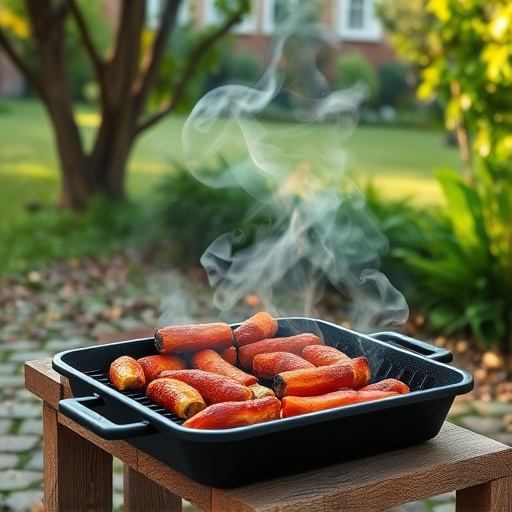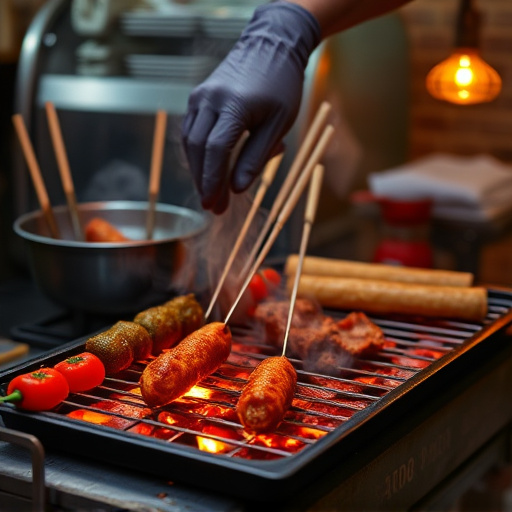Selecting the perfect cut of boneless pork shoulder or butt, well-marbled with fat, is key for an exceptional pulled pork BBQ. Cook slowly over indirect heat below 250°F (121°C) using wood chips or chunks for smoke, and maintain consistent temperature. Shred the tender meat after slow roasting, then enhance flavor with a dry rub or BBQ sauce. Top with coleslaw, pickles, cheese, crispy onions, or honey for a unique twist on your pulled pork BBQ recipe.
Unleash the ultimate smoky delight with our guide to crafting the perfect pulled pork BBQ. Discover the secrets to tender, juicy meat infused with a subtle yet captivating smokiness. From selecting the ideal cut of pork to mastering slow-roasting techniques, we’ll walk you through every step. Learn effective methods to enhance flavor and shape those tantalizing pulls. Top it off with delicious serving suggestions, toppings, and sauces to create a memorable pulled pork BBQ experience—all in the comfort of your own kitchen!
- Choosing the Right Cut of Pork for Pulled Pork BBQ
- Infusing Smoky Flavor: Techniques and Ingredients
- Cooking the Pork: Slow Roasting for Tender Results
- Shaping the Pulls and Seasoning the Meat
- Serving Suggestions: Toppings and Sauces for Your Smoky Pulled Pork BBQ
Choosing the Right Cut of Pork for Pulled Pork BBQ

When crafting a mouthwatering pulled pork BBQ, selecting the perfect cut of meat is a crucial first step. Look for a boneless pork shoulder or butt as your base. These cuts are ideal because they are well-marbled with fat, which ensures the pork stays tender and juicy during the slow cooking process. The fat also contributes to the rich, smoky flavor that defines pulled pork BBQ.
The pork shoulder or butt should have a good balance of muscle and fat, allowing it to break down easily as it cooks slowly. Avoid cuts with excessive gristle or hard, lean muscle fibers, as these can make the final dish tough. Opting for the right cut will set the stage for a truly exceptional pulled pork BBQ experience in your next culinary adventure.
Infusing Smoky Flavor: Techniques and Ingredients

To achieve a smoky flavor in your pulled pork BBQ recipe, there are several techniques and ingredients to consider. One popular method is to cook the pork slowly over indirect heat, allowing smoke to permeate the meat. This can be done using a smoker or by cooking it low and slow in a Dutch oven or crockpot. The key is to maintain a consistent temperature below 250°F (121°C) for several hours until the pork becomes incredibly tender.
In terms of ingredients, wood chips or chunks are often used to generate smoke. Popular choices include hickory, mesquite, applewood, and oak, each offering unique flavor profiles. These should be added to the smoker or heat source to create a subtle yet distinctive smoky taste in your pulled pork. Other enhancements like liquid smoke or smoked salt can also help intensify the desired flavor, but use them sparingly to avoid overpowering the natural pork taste.
Cooking the Pork: Slow Roasting for Tender Results
To achieve tender, succulent pulled pork with a smoky flavor, slow roasting is key. This method allows the meat to cook gently over low heat, transforming tough cuts into mouthwatering dishes like a classic pulled pork BBQ recipe. By keeping the oven temperature around 250°F (120°C), the pork slowly breaks down, ensuring each fiber becomes incredibly tender.
The slow cooking process also intensifies the natural juices within the meat, creating a rich and moist texture that simply melts in your mouth. This is especially important when infusing smoky flavors, as the heat gently carves through the meat, allowing the smoke to penetrate and coat each piece evenly.
Shaping the Pulls and Seasoning the Meat

When shaping the pulls for your pulled pork BBQ recipe, the goal is to achieve tender, shreds that melt in your mouth. Start by cooking the meat until it’s nearly fall-apart tender. This usually takes several hours on low heat, whether it’s in a slow cooker or an oven. Once cooked, carefully pull apart the larger chunks of meat with two forks, ensuring each piece is small enough to eat comfortably.
Seasoning is key to enhancing the smoky flavor infused into your pulled pork. Before shredding, brush the meat with your favorite BBQ sauce or a dry rub for extra taste. A classic blend includes paprika, brown sugar, salt, pepper, garlic powder, and onion powder. The seasonings not only add depth but also help keep the pork moist during the cooking process.
Serving Suggestions: Toppings and Sauces for Your Smoky Pulled Pork BBQ

Enhance your smoky pulled pork experience with a variety of toppings and sauces. The classic combination of coleslaw and pickles adds a refreshing crunch to each bite, balancing the rich, smoky flavor of the pork. For an extra kick, consider adding a dollop of barbecue sauce or a sprinkle of chili powder.
Other creative options include melted cheese for a gooey indulgence, crispy onions for a sharp contrast in texture, or even a drizzle of honey for a unexpected sweet-and-smoky twist. Experiment with different combinations to find your perfect pulled pork BBQ recipe.
